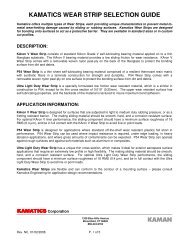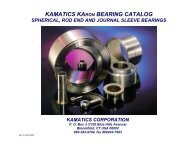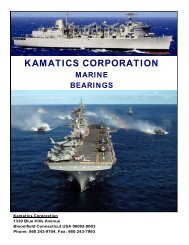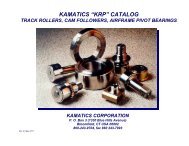Kamatics Karon Design Guide - Kaman Corporation
Kamatics Karon Design Guide - Kaman Corporation
Kamatics Karon Design Guide - Kaman Corporation
You also want an ePaper? Increase the reach of your titles
YUMPU automatically turns print PDFs into web optimized ePapers that Google loves.
KAMATICS CORPORATION<br />
the mating track or cam. Figure 9<br />
shows a studded roller assembly.<br />
Figure 9, (stud mounted roller)<br />
The worst-case scenario is when the<br />
roller contact is at the extreme end of the<br />
outer race, away from the threaded end.<br />
The bending moment arm is the longest<br />
at this point, imparting maximum stress<br />
on the stud. This is not a problem unless<br />
the stud is not of sufficient size to safely<br />
react the implied stress. There are<br />
various methods to analyze the bending<br />
stresses in a cantilevered roller and this<br />
is normally the responsibility of the<br />
bearing user. The same concern as to<br />
where the outer race will contact the<br />
mating surface exists with a clevismounted<br />
assembly, however, the<br />
bending consideration is at a minimum.<br />
The concern here is more of track/cam<br />
contact and bolt shear stresses. Bolt<br />
shear is usually not a major concern as<br />
there is double shear involved with a<br />
clevis arrangement.<br />
There are ways to minimize the bending<br />
concern on a studded roller. One is to<br />
incorporate a “crown” radius on the OD<br />
of the roller in an attempt to bring the<br />
contact point nearer the center of the<br />
outer race width. This is the most<br />
common approach with anti-friction<br />
bearings, however, this ensures that the<br />
contact stresses on the track or cam will<br />
be high because of the more localized<br />
contact area. This is not a problem as<br />
long as the stresses are within the<br />
material’s capabilities.<br />
A second approach to minimizing both<br />
the bending and contact stress<br />
considerations is the patented <strong>Kamatics</strong><br />
10<br />
KAMAN<br />
self-aligning roller. This design<br />
incorporates a KAron lined spherical<br />
inner race that operates against the same<br />
hardened outer race material as the more<br />
common “KRP” design. The spherical<br />
feature allows the roller to conform/align<br />
to the mating track/cam surface without<br />
the high contact stresses and with a<br />
reduced bending moment arm that can<br />
be considered to pass through the<br />
centerline of the outer race width.<br />
Figure 10 illustrates the self-aligning<br />
design.<br />
Figure 10, (self-aligning roller)<br />
Extensive testing and field results have<br />
shown that a KAron lined track roller<br />
will operate successfully for an extended<br />
duration at dynamic bearing pressures as<br />
high as 20,000 psi (140 mPa). For most<br />
commercial aircraft flap/slat roller<br />
applications or similar, by keeping the<br />
bearing pressures to a maximum of<br />
12,000 psi (85mPa), the roller can<br />
yield in excess of 200,000 revolutions<br />
of useful life with liner wear less than<br />
0.004 inches (0.10mm). As is obvious,<br />
if as many as 200,000 revolutions are not<br />
required, the bearing pressures can be<br />
increased. This is normally the case of<br />
military aircraft, where space is small,<br />
loads are higher but the number of<br />
cycles is lower. <strong>Kamatics</strong> engineering is<br />
available to assist in sizing the roller for<br />
any application under consideration.<br />
“KRP” Linkage/Bellcrank Pivot Bearings:<br />
Prior to the <strong>Kamatics</strong> self-lube KRP<br />
design, the typical linkage/bellcrank<br />
pivots bearings were mainly limited to<br />
ball bearings or greased journal bearings.<br />
The “KRP” design for these applications







